Letters from Lodi
An insightful and objective look at viticulture and winemaking from the Lodi
Appellation and the growers and vintners behind these crafts. Told from the
perspective of multi-award winning wine journalist, Randy Caparoso.
Some twenty-first century wine tasting terms, part 1 (nose)
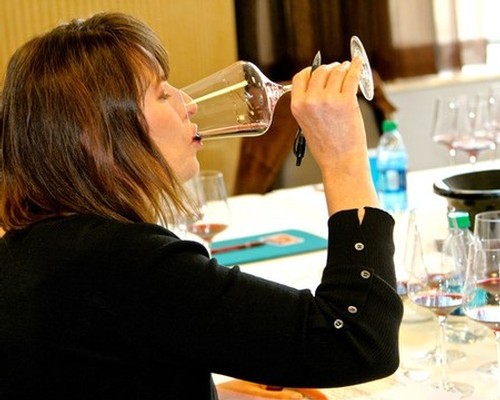
Acclaimed San Francisco-based wine educator and journalist Deborah Parker Wong examining Lodi wine
A little knowledge goes a long way. It's also said that a little knowledge can be dangerous. I can't agree with that. What's actually dangerous, particularly to yourself, is not enough knowledge.
That's what is difficult about contemporary wine tasting. Many of the wines we are often asked to appreciate today do not exactly comport with the usual "how to taste wine" instructions found in books, online pages, or videos. It's one thing to learn how to see, smell and taste wine, but it's another thing to understand what you are seeing, smelling, and tasting. Maybe even more important: Exactly why you are seeing, smelling, and tasting certain things.
Quick answer as to "why": Wine producers everywhere in the world these days are very good at what they do. 99% of what you taste in a given wine is exactly what they want you to taste. The grape growing and winemaking industries have become so sophisticated, producers can engineer just anything within the scope of verbiage found on wine labels.

(image courtesy of San Francisco Wine School)
Take, for example, your typical Chardonnay from an appellation in, say, California. Virtually every Chardonnay tastes like a fruit suggesting apples, a touch of lemon, and often pineapple, which are the aromatic expectation of the Chardonnay grape's "varietal character." It will almost always have the smell of vanilla or cream, often with a tinge of charred or toasted wood — all of which comes from contact with oak barrel wood. The best Chardonnays from the U.S., Australia or New New Zealand, South America, or France where the Chardonnay grape originated all have this same combination of fruit and wood, mostly because they come from excellent vineyards and are aged in oak barrels.
But what about all the Chardonnays selling for $5 to about $20 in your typical American retail or grocery store? Guess what: Virtually none of them are actually aged in oak barrels, even though they taste like it. Instead, these are wines fermented and finished entirely in stainless steel tanks and simply flavored with oak with the use of what the wine industry calls "adjuncts" — usually bags of chips or staves dipped into the tanks, custom charred with just the right amount of "toast" to replicate the smell and flavor of Chardonnay aged in barrels.
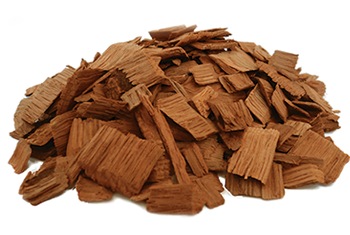
Oak chips (image courtesy of Oak Wise, a winery supply company)
Why does the industry do this? Because actual oak barrels are so darned expensive — according to a recent Wine Folly report, $360 to $500 for barrels made from American-grown wood, or $850 to $3,600 for the really good stuff grown and made in France. Yet the average consumer expects Chardonnay to taste like apples and lemon with creamy or vanillin oak embellishments — especially sensations that suggest luxurious French oak. Therefore, the only way this taste profile can be achieved for less than a $20 retail bottle price is with the use of amendments, which can be done artfully.
But apples, lemon, cream, and vanilla are just one part of the sensory profile of a Chardonnay. If all Chardonnays smelled and tasted exactly like that and only like that, then the world of Chardonnays would be extremely boring. The best or most interesting Chardonnays, in fact, are full of nuanced qualities and complexities delineating them from other Chardonnays. Otherwise, why buy a Chardonnay by this brand or that, or coming from this appellation or another? Why spend, say, $30 or $50 instead of just $5 or $10?
That's where a little extra knowledge — particularly about how wines are made, their origins, and how they are perceived — comes in. Think of it like buying a car. A lot of cars look great; but unless you've studied or have been told about all the special features of a car, all cars are pretty much the same. You've got to have at least a little idea of what makes a car special the same way that it helps to understand a little more about what you are tasting in a wine.
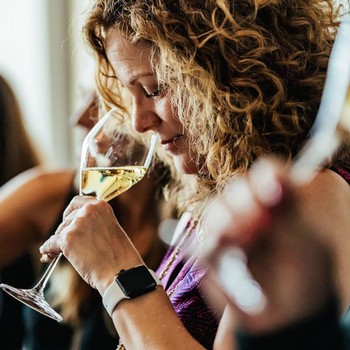
(image courtesy of San Francisco Wine School)
That said, here is a little bit of terminology that might help you increase your understanding of what you're tasting in the wines of today, starting with the ideas or concepts related to what is perceived through the nose:
Aroma
The smell of wine derived from grapes. In an older interpretation, the aroma was distinguished from "bouquet" with the understanding that the latter term is associated with smells that evolve in wine as a result of bottle maturation. In contemporary practice, the concept of bouquet has pretty much fallen out of usage, and aroma is used to describe any smell — from grapes, resulting through the fermentation process, and also evolving after time in a bottle. Instead, with the growth of wine magazines and literature in general, the more pressing distinction has become the difference between aromas you can smell and aromas you can actually identify since sensory profiles do not become distinguishable unless you can put a word to them.
Aromas, after all, are perceived by physical receptors in the nose which relay signals with attendant information to the brain via nerve endings. Therefore, an average person may perceive the scent of lemon, black pepper, or rose petal — all smells found commonly in wines — but if the brain does not identify them as such, these smells are essentially nonexistent or remain an unconscious response, but are certainly not consciously appreciated.
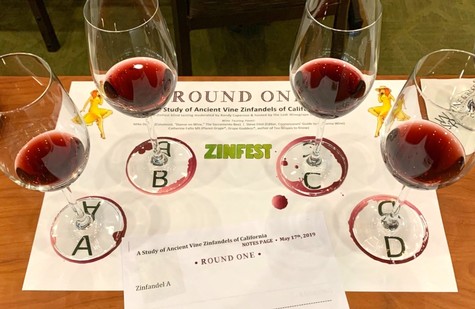
Lodi ZinFest Zinfandel blind tasting (image courtesy of pullthatcork.com)
Complicating this is the fact that human beings do not smell things in the same ways for both physical and experiential reasons. Most wine lovers, for instance, are not sensitive to the smell of black pepper in wine, whereas there will always be a minority of wine lovers who can greatly appreciate the peppery spice qualities typically found in a Syrah, a Zinfandel, or a Grenache. Still, another factor is the fact that smells are connected to sensations perceived on the palate (the five basic sensations perceived on the tongue being sweet, sour, bitter, salty, and umami) because the human experience of taste is syncretic — that is to say, sensations that have accumulated and merged in our memory banks.
So when you smell a fresh lemon, for instance, your brain perceives it as palate sensations that are both refreshing and maybe a little bit sour, even though "sour" is a taste perceived on the tongue. The scent of lemon may also trigger memories of sweet/sour lemonade, hot and sweaty summer days, and other related emotions originating from a stand your parents may have helped you set up when you were 10 years old. The nose can even perceive sensations that are "hot" (like pepper), "cold" (menthol), "dry" (wood, like pencil shavings), or "sweet" (vanilla, spearmint, or cinnamon). This is sensory syncretism, which is very much aroma related. Aromas, in other words, are our most effective way of delineating and appreciating wines, and therefore are never to be overlooked.
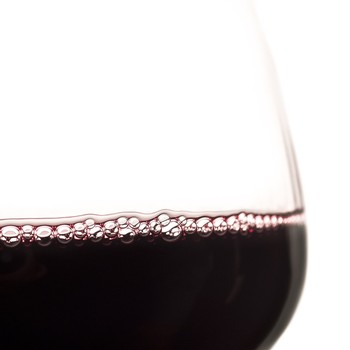
(image courtesy of San Francisco Wine School)
Varietal
A type of wine named after the predominant grape in its composition. Federal guidelines require American wines to have a minimum of 75% of the grape identified on a varietal wine label (individual states — such as Oregon, which has a 90% requirement — may have stricter standards). This term is correctly used when referring to the identity of a grape going into a commercial bottling but is often incorrectly used when referring to the botanical identities of grapes. The Cabernet Sauvignon grape, for instance, is never a "varietal," it is a grape, a variety, or a cultivar. There are other sticklers for proper wine language who still say that "varietal" can only be an adjective, not a noun. The word, however, has long entered the domain of commonly accepted usage as either a descriptor or a wine type or category.
Where varietal terminology becomes tricky for American wine producers, however, is that only grapes formally recognized by the TTB (Alcohol and Tobacco Tax and Trade Bureau) may appear on a label. The pioneering Lodi grower/producer Bokisch Vineyards, for instance, was not allowed to label their first vintage (2001) of Graciano as "Graciano" because the grape was not listed by the TTB. After submitting evidence for Graciano's long-established history in Spain, the Bokischs were able to get the grape listed and bottle their second vintage as Graciano.
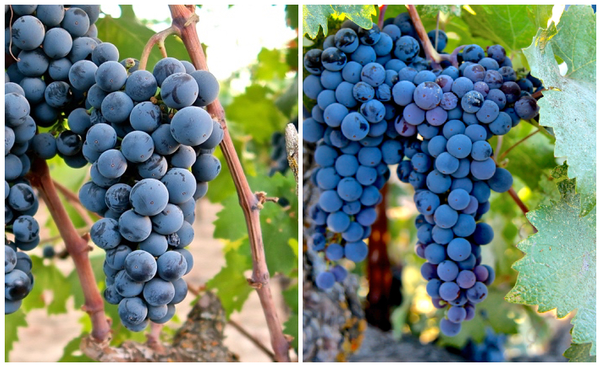
Lodi grew Primitivo (left) vs. Zinfandel (typically a tighter bunch with more uneven-sized berries than Primitivo)
The Primitivo vs. Zinfandel question is another example of TTB quirks. Primitivo is a clonal variant of Zinfandel, sharing the same DNA, and many growers prefer the attributes of Primitivo over that of other Zinfandel selections. The TTB recognizes Primitivo as a separate varietal category, and therefore many California wineries bottle a Primitivo separately from their Zinfandel. However, most growers sell their Primitivo grapes to wineries as Zinfandel — because that's exactly what it is. Therefore, the vast majority of Primitivo grown in California is actually bottled as Zinfandel, regardless of TTB standards. This is not deception, it's just logic.
Marzemino is still another example of a grape that is not recognized as a grape eligible for varietal labeling, even though it has been cultivated by Lodi's Hux Vineyard since the late 1990s. Wineries have been getting around the rules by submitting their back labels as their front labels for TTB approval, identifying the wine simply as a "California Red Table Wine." But because actual back labels are not as stringently regulated as front labels, you may prominently show the wording "Hux Vineyard Marzemino" — and this is what the consumer sees. In the wine world, you simply do what you can.
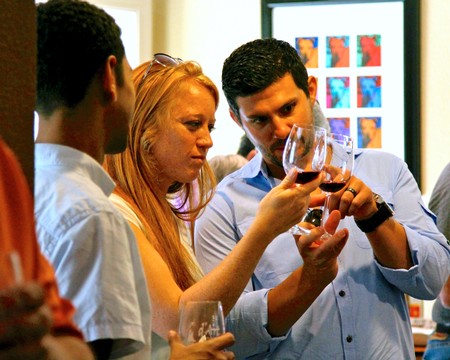
Wine lovers at Lodi's d'Art Winery
Varietal character
A term used to describe sensory qualities associated with a particular grape identified on the label of a bottling. The varietal character of a Cabernet Sauvignon, for instance, is usually that of a red wine that exudes aromas of blackcurrant, dark berries, and some degree of herbaceousness, with a full body and generous tannin. The varietal expectation of a Zinfandel is that of a very berry-like red wine, medium to full in body/tannin and zesty in flavor. One drawback of evaluating wine quality in terms of varietal character is that, as in all things, perception is everything. Wine critics, for one, tend to have different conceptions of what constitutes a varietal wine's ideal qualities, and the perspectives of wine critics, in general, have grown increasingly different from that of, say, the sommelier trade.
A second drawback is that more and more consumers are perceiving wine quality in terms of terroir, or "sense of place," regardless of how well a wine meets varietal expectations. Since the terroirs of, say, Rutherford in Napa Valley and the Adelaida District in Paso Robles are so different, it doesn't make sense to evaluate their Cabernet Sauvignons in terms of the same varietal profile. Same thing for Zinfandel grown in Sonoma's Dry Creek Valley as opposed to Lodi's Mokelumne River.
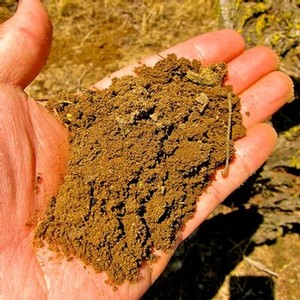
Loose, porous yet richly organic Tokay series sandy loam soil, one of the defining elements of Lodi terroir
The movement away from expectations of varietal character has been an inevitable part of the evolution of the American consumer, trade as well as media, as more and more commercial wines are appreciated for their representation of respective regions or vineyards rather than for their fulfillment of varietal character — a way of looking at wine long associated with the finest wines of Europe which are largely labeled by place names rather than by the brand/varietal formula typifying the American wine industry (a system established only because, in the 1970s when varietal wines began to supplant generic wines in popularity, American wines weren't nearly as distinctive or geographically diverse as they are today, and thus sensory characteristics associated with regions or vineyards were still a huge blank).
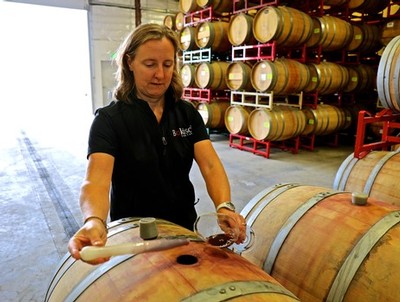
Bokisch Vineyards winemaker Elyse Perry sampling "Gran Reserva" Tempranillo from barrels
Oak qualities in wine
Wines aged in oak barrels or casks will retain a partial amount of the aroma and flavor of those oak vessels, which are primarily variations of vanillin qualities, often in combination with roasted or "toasted" qualities derived from the charred surface of the insides of barrels, the staves of which are bent over open flames during the barrel making process. Oak barrels also contribute a modicum of tannin to wines, adding to the sense of body and structure. Varietals such as Cabernet Sauvignon, Tempranillo, and Chardonnay are known for their ability to attain increased richness, enhanced texturing from barrel-aging's oxidative process, and additional complexity through fruit/oak interaction during longer periods of time in contact with wood, particularly with the use of new barrels which are strongest in oak flavors (after three or four years of usage, barrels contribute fewer oak flavors, reaching a point where they are considered "neutral barrels").
More recently (since, say, 2010), certain camps in the wine industry, as well as more consumers, have begun to take a dimmer view of oak influences in wine, preferring wines that are aged strictly in neutral barrels or no oak at all in order to better appreciate either purer fruit qualities or the subtle qualities reflecting terroir, both of which tend to be obscured when oak aromas and flavors play an aggressive role.
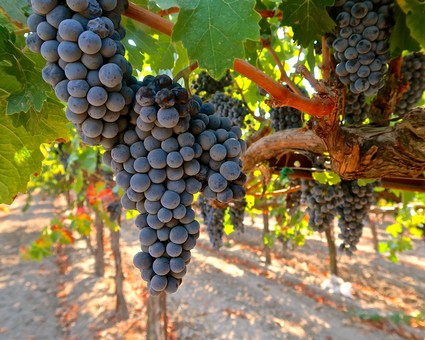
2020 Cabernet Sauvignon in Michael David Winery's Phillips Farms
Methoxypyrazine (i.e., pyrazine)
Odoriferous class of chemical compounds giving green, herbal, or herbaceous aromas akin to the smell of cut bell pepper, asparagus, or fresh cut grass. Grape varieties that tend to be strong in methoxypyrazine include Cabernet Sauvignon, Cabernet Franc, and Sauvignon blanc (not coincidentally, Cabernet Franc and Sauvignon blanc are the parent grapes of Cabernet Sauvignon). Herbaceous aromas are also indicative of any variety that is picked underripe, or before it has matured past its vegetal stage and into a mature fruit profile. While the inference is that herbaceousness is a flaw, this quality is considered a positive in many styles of Cabernet Sauvignon, Cabernet Franc, and Sauvignon blanc (taste, as always, being in the mind and palate of the beholder).
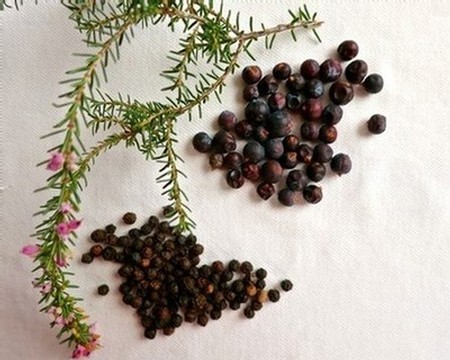
Rotundone
Rotundone is the aromatic compound (a sesquiterpene, a class of terpenes) responsible for the "spicy" or "peppery" aroma and taste commonly found, first in foremost, in peppercorns, but also in other plants like juniper, geranium, and various kitchen herbs. In wines, rotundone is more commonly found in perceptible in grapes such as Syrah, Petite Sirah, Grenache, and Zinfandel, although research indicates that only approximately 20% of wine drinkers readily recognize the peppery spice quality of rotundone in wines.

Lodi grew Sauvignon blanc, producing a wine that often expresses mineral qualities by dint of high natural acidity and thiols
Minerality
The perception of minerals, stones, or an earth-related component in a wine's nose or palate feel, often in the presence of less fruit or floral sensations. Minerality as nuance is associated more with white wines and rosés than red wines because the winemaking process of the latter (fermentation with skins and oak aging) tends to veil mineral-related subtleties.
There is, however, some disagreement in the industry concerning the origin of mineral sensations. For wines such as Sauvignon blanc, for instance, minerality is often associated with the presence of sulfur-containing compounds identified as thiols (an organosulfur); thus, winemaking methods to increase the positive quality of thiols are now commonly employed to increase mineral complexity in Sauvignon blanc.
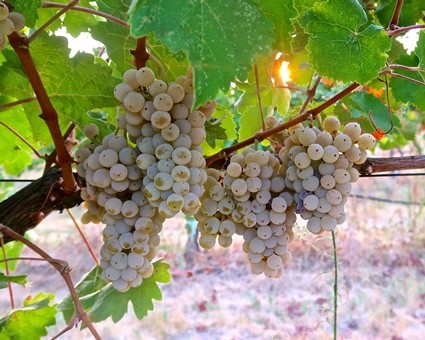
Lodi-grown Kerner grapes, another variety known for dry white wines with mineral profiles
An increasing amount of weight is given to the premise that minerality is closely associated with wines higher in acidity; and it is no coincidence that cold climate Chardonnay from places like France's Chablis, or Rieslings grown in the coldest regions of Germany such as the Mosel-Saar-Ruwer, are higher in mineral sensations than comparable wines from warmer regions with lower acidity.
Minerality is also associated with grape varieties such as Vermentino, Kerner, Piquepoul, Inzolia, and often Albariño that tend to retain mineral qualities even when grown in warm Mediterranean climate terroirs such as Provence, Sicily, or Lodi, but picked early enough to retain high natural acidity — also suggesting that the phenomenon is related to pH (i.e., measurement of the strength of acidity).
If anything, it is now universally agreed that mineral sensations are not the result of the uptake of mineral components directly from the soil. It is not possible for grapevines to manufacture flavors in grapes in this way; therefore, the composition of a given vineyard's soil is not a factor in this discussion.
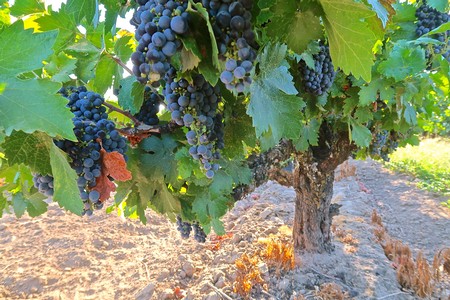
Classic Lodi old vine Zinfandel, producing fragrant, often earthy styles of wine typifying the region's sandy loam soil and Mediterranean climate
Terroir
French term is frequently employed because of its effective way of describing the natural environmental factors — such as climate, soil, topography, aspect (direction of slope), elevation, latitude, etc. — that have a direct effect on grape qualities. Because vineyards, like wines, involve human input, viticultural traditions typical of regions or eras are often considered part of a region's or vineyard's terroir. The term is also frequently applied to sensory qualities in resulting wines in their expression of a "sense of place," when there is less priority placed on qualities such as varietal character or brand style.
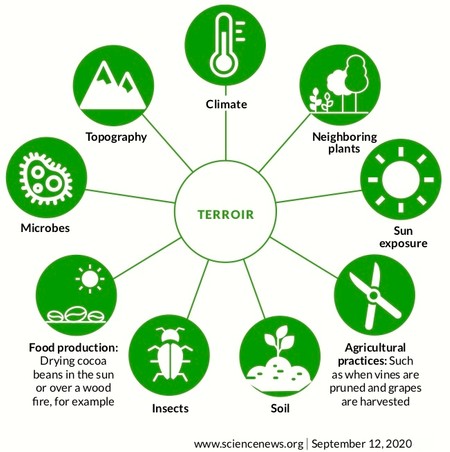
(image courtesy of Science News)
On a sensory level, a wine's expression of terroir is not necessarily, as the word implies, an earth or mineral-related quality, although earthy or mineral qualities can certainly be part of it. More often, terroir-related distinctions are expressed through the aromatic and structural profiles of wines. Lodi-grown Zinfandels, for instance, are known for their fragrant, red fruit qualities (typically suggesting cherry), often with black tea-like nuances, whereas Zinfandels grown in heritage vineyards in Sonoma County or Napa Valley have less floral profiles yet deeper aromas, often suggesting blacker fruit (like blackberry or plum) mixed with red berries. Lodi Zinfandels are also generally softer in tannin, and Sonoma and Napa Zinfandels are firmer and grippier. These distinctions are the direct result of differences in terroir — North Coast Zinfandels typically grown in shallower, rockier, often hillside soils in climates with more pronounced diurnal (i.e., night/day temperatures) swings, as opposed to Lodi Zinfandels grown in extremely deep, sandy soils on flat terrain, in a slightly warmer climate with more moderate diurnal swings.
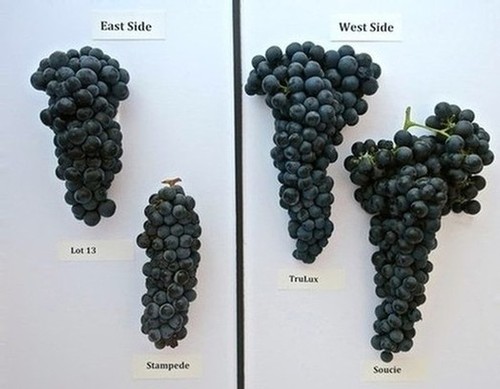
Impact of terroir: east vs. west side Lodi Zinfandel clusters, producing different cluster morphology as well as wines with distinctive "east" or "west" side qualities
You can take it further by comparing terroir-related characteristics of Zinfandels grown on the west side vs. the east side of the City of Lodi. West side Lodi Zinfandels are typically earthier — with aromas suggesting some kind of loaminess — whereas east side Lodi Zinfandels are even more floral, with almost no earth tones. Old-timers in the Lodi wine industry have known these differences forever. It is not something anyone plans for. Distinctive "sense of place" happens because wines are made from grapes, and grapes respond differently to different environments — and even a matter of just 1, 2, or 5 miles separating east side Lodi vineyards from the west side can make a difference.
It follows that qualities expressing terroir are usually associated with wines made with minimal intervention — typically, with the use of native yeast for fermentation, no use of enzymes, acidulation or wood adjuncts, or aging in older, neutral barrels (protocols required, for example, in Lodi grown wines bottled under the Lodi Native label) — or in a "natural" (another unregulated term) style less likely to obscure subtleties reflecting grape sources. Focus on terroir, if anything, has proven very useful for many Lodi-based producers as a way of demonstrating vineyard-related characteristics unique to the region, thereby helping to better define "Lodi."
Next week: Some twenty-first-century wine tasting terms, part 2 (palate sensations)
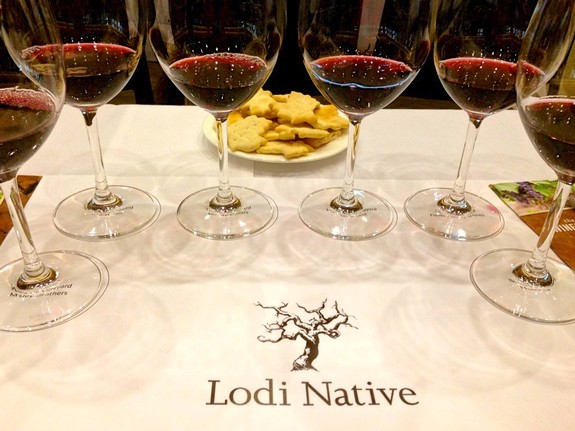
Lodi Native Zinfandel tasting